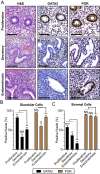Immunohistochemical Analysis of GATA2 Expression in Endometrium and its Relationship with Hormone Receptor Expression in Benign and Premalignant Endometrial Disorders
- PMID: 39443360
- PMCID: PMC11611599
- DOI: 10.1007/s43032-024-01730-5
Immunohistochemical Analysis of GATA2 Expression in Endometrium and its Relationship with Hormone Receptor Expression in Benign and Premalignant Endometrial Disorders
Abstract
The GATA gene family encodes highly conserved zinc-finger transcription factors that facilitate the development and function of multiple organ systems including the uterus. In the endometrium, GATA2 functions in a positive autoregulatory loop with the progesterone receptor (PGR) and colocalizes with PGR on chromatin to promote PGR transcriptional programs. GATA2 also has PGR-independent functions that maintain endometrial cell identity, and GATA2 transcripts reportedly are down-regulated in endometrial disorders including endometriosis. This event is accompanied by a reciprocal increase in GATA6. Here, we applied custom anti-GATA2 monoclonal antibodies and performed GATA2 immunohistochemistry (IHC) on patient endometrial tissues corresponding to proliferative, secretory, inactive, and hormone-treated endometrium, as well as endometriosis and endometrial atypical hyperplasia/endometrioid intraepithelial neoplasia (EAH/EIN). We also performed IHC for the estrogen receptor, PGR, and GATA6 in relevant groups. The results reveal a tight correlation between GATA2 and PGR expression in the glandular and stromal cells of benign endometrium. GATA2 expression is markedly reduced in stromal but not glandular cells in endometriosis and EAH/EIN. This reduction in GATA2 expression does not lead to a detectable increase in GATA6 expression in endometriosis. Although average glandular GATA2 expression was preserved in endometriosis and EAH/EIN cases, its expression was decoupled from PGR, implying that alternative pathways regulate GATA2 levels in these disorders. Our findings indicate that GATA2 dysregulation is a feature of endometriosis and EAH/EIN, and support a model whereby loss of stromal GATA2 in these disorders contributes to their progesterone insensitivity.
Keywords: Endometriosis; Endometrium; GATA2; Hyperplasia; Progesterone receptor.
© 2024. This is a U.S. Government work and not under copyright protection in the US; foreign copyright protection may apply.
Conflict of interest statement
Declarations. Conflict of Interest: The authors declare no conflicts of interest.
Figures




References
-
- Critchley HOD, Maybin JA, Armstrong GM, Williams ARW. Physiology of the endometrium and regulation of menstruation. Physiol Rev. 2020;100:1149–79. 10.1152/physrev.00031.2019. - PubMed
-
- Fazleabas AT, Strakova Z. Endometrial function: cell specific changes in the uterine environment. Mol Cell Endocrinol. 2002;186:143–7. 10.1016/s0303-7207(01)00655-4. - PubMed
MeSH terms
Substances
Grants and funding
LinkOut - more resources
Full Text Sources
Medical
Research Materials

